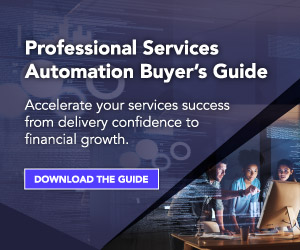
Despite facing massive and unprecedented challenges due to the pandemic, the professional services sector has not just weathered the storm over the last couple of years: it has thrived. Between 2021 and 2025, the global professional services marketplace is projected to grow from USD $5.428 trillion to $7.063 trillion, which is a compound annual growth rate (CAGR) of 7.9 percent.
While all models of service delivery are growing, research by Service Performance Insight has found that embedded service organizations (ESOs) are leading the surge. In 2020, ESOs within SaaS companies and Management Consultancies represented the highest growth segment in the professional service marketplace.
At Planview PSA we continue to “Build the Future of Connected Services,” which enables professional service organizations to fully connect, plan, and collaborate, while they work across the entire services lifecycle and within the context of the enterprise in which they live. A core part of this focus and commitment is serving ESOs as they work to streamline their product and customer strategy and adapt to meet the varying needs of their customers.
Below we outline four critical challenges that ESOs are facing, and how to solve them:
ESOs Must Serve Two Masters: Profits & Product Adoption
ESOs are typically part of a product company. However, their goal is not just to effectively deliver engagements. They must also enable product adoption, in order to increase product expansion and renewal rates. As such, to be successful ESOs face the challenge of serving not one, but two masters: profits and product adoption. To address this challenge, ESOs should consider changing their engagement models to fit the need. For example, initial implementation projects can be time and materials (T&M) based. And to encourage long-term adoption, ESOs can offer subscription models that give customers on-demand services such as ongoing configuration, training, and reporting assistance.
ESOs Must Contribute Non-Billable Time to Achieve Overall Success
As noted above, ESOs play a key role in optimizing product adoption and driving renewals. To achieve this, ESO teams engage in various activities such as advising product with field feedback, working with support on customer issues, helping marketing understand customers better, and so on. Yet while all of this work is valuable, only some is billable. As pointed out by Service Performance Insight:
While [embedded services teams] are focused on professional service revenue and profit, they are often asked to perform non-billable presales, proof of concept and customer satisfaction services at little to no charge. They enable external clients, but must also support internal sales, support and engineering constituencies.
Service Performance Insight
To address this challenge, ESOs should have a productive utilization target, alongside a billable utilization target. There are two practical and strategic benefits of this approach:
- It highlights (through reports, presentations, updates, etc.) the full contribution that ESOs are delivering.
- It enables ESOs to monitor utilization trends and patterns, and escalate issues as necessary. For example, if the productive utilization target for a quarter is on pace to be reached in just a month, an ESO can determine if this is a one-time outlier or the “new normal.” If it is the latter, they can proactively discuss with the product company to align expectations and avoid problems down the road.
ESOs Must Align Their Goals with the Company’s Strategic Objectives
ESOs live inside a product company whose strategic goals and objectives often revolve around the product — not around delivering professional services. As a result, ESOs must find ways to succeed in an ecosystem where they serve rather than drive corporate strategy.
To overcome this challenge, ESOs should ensure that their services offerings and packaging support the company and its product strategy. This could include developing subscription services that drive adoption, incentivizing staff on customer retention, or adding service offerings for new products in new markets. These efforts are often achieved through internal projects, which tie into larger corporate programs. The ability to track these in the corporate portfolio and project management (PPM) solution is critical to keeping services in sync with the rest of the company.
ESOs Need to Adjust to an Accelerated Lifecycle on the Post-Pandemic Landscape
Many ESOs plan to continue delivering at least some services remotely after COVID-19, including services that were previously delivered on-site. This shift to remote work is significantly impacting operations, and forcing them to accelerate digital transformation, leverage automation, and optimize an approach to collaboration that is designed for distributed vs. co-located team members.
While delivering services remotely can be more efficient, productive, and profitable than delivering services on-site, there can be pitfalls as well. Notably, delivering services remotely greatly accelerates the lifecycle — tasks or workflows that previously took a week might now take a day — which puts teams at risk of becoming overburdened with the overhead.
To address this challenge, ESOs should adopt a cloud-based PSA solution that empowers the full engagement lifecycle for speed and scale, and allows them to:
- Deliver quality engagements consistently for higher customer satisfaction.
- Proactively manage capacity, availability, utilization, skills and extended (virtual) bench.
- Analyze and forecast staffing needs for new opportunities and current engagements to decrease revenue leakage and increase profitability.
- Rapidly and accurately log time and other items quickly — which is critically important when consultants are switching gears between various customers throughout the day.
- Gain a competitive edge with visibility, accuracy, and adaptability to drive speed across the entire engagement cycle.
- Shift from T&M to more profitable remote, hybrid, subscription, and outcome-based offerings.
The Final Word
ESOs that address and overcome these challenges are poised to thrive in the post-pandemic environment as they:
- Establish consistency and enable the method that best fits the engagement.
- Scale with the business and generate insights, predictability, and flexibility to support modern business models.
- Connect and optimize across all the elements so to run services at the speed of business — but without getting overloaded or overwhelming consultants.
Conversely, ESOs that neglect to address and overcome these challenges will struggle to succeed — and in the long-run given how relentlessly competitive the professional services space has become, to survive.
Looking for more insights on services automation and professional service automation solutions?
- Adopting a PSA solution is not a one-time transaction. Invariably, your leaders and teams will need a full range of support: everything from strategic advice to hands-on adjustments.
Contact us to discuss how Planview can help make your organization’s engagements more predictable and profitable.


